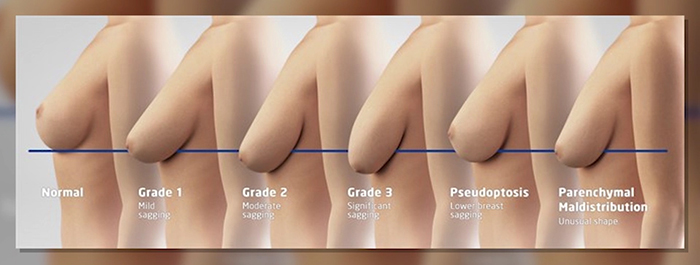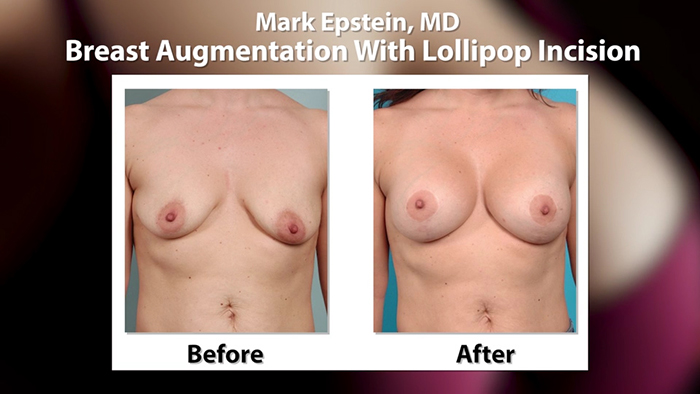To lift or not to lift, that is often the question. For the tens of thousands interested in breast augmentation surgery each year, many may in fact require a breast lift to achieve the look they’re after. Every woman wants her breasts to look firm and be positioned high. For some women, an augmentation alone can accomplish a firmer, perkier chest. For other women, a lift is needed at the time of augmentation in order to remove loose skin, reposition the nipple and improve the shape of the breast.
Most of the time, cases are clear-cut and the decision is straightforward. When a woman has small, perky breasts and wants more volume, it is obvious they do not need a lift. On the other hand, when a patient has lots of extra skin, sagging breast tissue and the nipples point toward the floor, they are often already aware that they will need a lift.
“The question is the ‘in-between’ breasts,” shares board certified plastic surgeon Dr. Mark D. Epstein of Stony Brook, New York. “The breasts where the nipples are a little bit low, they’re still pointing forward, but they’re lower than ideal. There’s some loss of fullness in the breast up top, and there’s some bottoming out below.”
Horizontal Line Test for the ‘In-Between’ Breasts
Over time, breast surgeons have developed a loose set of guidelines that help make the judgement call on whether a patient should undergo a lift at the same time as an augmentation, or proceed with an augmentation alone.
First, Dr. Epstein examines the quantity of breast tissue and the amount of excess skin. Next, in order to determine the extent of nipple malposition, he performs a quick test. “I’ll look at the patient from the side, and I’ll draw a line from the lateral crease of the breast parallel to the floor. If I see the nipple is above that, in most cases, I don’t need to do a lift,” he explains.
Factors Considered When Determining the Need for a Lift:
- Nipple Position
- Quantity of breast tissue
- Quality of breast tissue
- Quantity of skin
- Quality of skin
Donut vs. Lollipop: Choosing the Right Lift Technique for the Best Result
If the decision is made to lift the breast, the surgeon and patient will then need to decide which type of lift will be done. Lift techniques are often differentiated by the shape of the incision and the resulting scar. The length of the incision at the time of surgery determines the amount of skin that can be removed.
At minimum, a lift will result in a scar around the nipple. The incision that circles the nipple is known as a periareolar lift. The periareolar incision allows the surgeon to reposition the nipple to the center of the breast mound and it also allows for some skin to be removed in a donut shape around the areolar incision. “The way that wound heals is often not ideal,” shares Epstein. “Periareolar lifts sometimes widen, the scars can be thicker and raised, and I’m not a big fan of them.”
Epstein’s preferred method of breast lift is a technique called a circumvertical lift, also known as a “lollipop lift” due to the shape of the incisions. In a circumvertical lift, the incision is placed around the nipple, as it is in a periareolar lift, but an additional incision is also used that runs vertically from the nipple down to the fold below the breast.
“Even though there is, again, a scar around the nipple, the biomechanics of how the wounds heal are different,” explains Epstein. “Those periareolar scars tend to heal quite nicely, and the vertical scars fade a lot. I’m not going to say the scar is invisible, but they’re less noticeable, and that allows me to redistribute breast tissue and bring the breast tissue back up over the implant where it needs to be rather than below the implant, and put the nipple in the right position.”
When In-Between Could Go Either Way
There are times when even after careful examination and consideration the decision to have a lift or not to have a lift could go either way. In those cases, Dr. Epstein usually recommends moving forward with the breast augmentation alone, with plans to re-evaluate the result six months later.
For the in-between patients, Epstein uses an augmentation technique known as dual plane augmentation. In dual plane augmentation, the implant is positioned under the muscle in the upper portion of the breast and is below breast tissue only in the lower portion of the breast. This positioning of the implant allows the implant to fill out the lower portion of the breast and provide some “lift” to the natural breast tissue sitting above.
“I know that with the dual plane technique, that implant is going to come down, fill out the lower breast, push the nipple forward and get it to come up a little bit,” he explains. “And so far, I’ve yet to have to go back on any of those patients and do a lift.”



















Facebook
Twitter
Instagram
YouTube
RSS